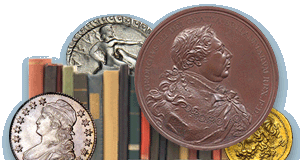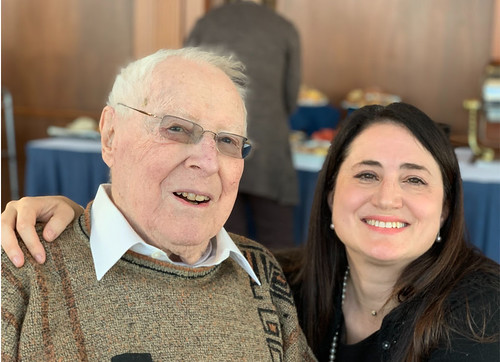
PREV ARTICLE
NEXT ARTICLE
FULL ISSUE
PREV FULL ISSUE
CARL SUBAK COLLECTION OF ROMAN QUINARIIIn her email Newsletter #227 this week, dealer and NBS Board Member Shanna Schmidt wrote about the upcoming Numismatica Ars Classica (NAC) Spring sale of the collection of Roman Quinarii of her late friend Carl Subak. We're republishing her introduction to the catalog here with permission. -Editor As many know, Carl was a longtime numismatist and friend to me. He died in 2022 at the age of 103. Among the coins Carl treasured, Roman quinarii ranked high. I would like to share my forward to the catalog below. His son Jon also wrote a lovely forward but I'll leave that for when the catalog is published.
Years later, starting in 2005, we met regularly for lunch at The Italian Village in Chicago, where Carl had a regular table nestled in the upstairs dining area. There, we shared many stories; I asked Carl about his years in the coin trade, and he asked me about the current auction market. Carl knew names from the past that we only now see in auction catalogs – people like Erich and Herbert Cahn, Leo Mildenberg, and Pierre Strauss. He told stories about how he nabbed his first significant collection from George Bauer in the 1950's. He used every penny he had at the time, approximately $27,500, to win the sealed bid. When Carl turned 100 years old, I started a series of videos where I began to document his life. Carl granted my request with eagerness. He wanted me to share his story with others, and I promised him that I would. I now get to honor that promise. Carl was a gentleman: quiet, kind, and well-spoken. When you got to know him, you quickly realized he was not interested in being the center of attention. Perhaps this was due to a traumatic yet heroic story of survival. If Carl were still alive, he certainly would not want me to dwell on this, but I feel it is essential to never forget. Carl came from a prosperous Jewish family living on the Austrian/Czech border during the Austrian Hungarian Empire. His family worked in the leather business and was even recognized as a Kaiserliche König Gesellschaft (often abbreviated as k.k. or k.u.k.) in Austria-Hungary, which meant "Imperial-Royal" and designated the authorities and state institutions of the Austrian Empire before 1867 until 1918. Carl was born in January 1919; just one month later, the last Kaiser of the Austrian Hungarian Empire, Charles I (the great-nephew of Franz Joseph) was formally dethroned. His childhood home was close to the Roman site of Carnuntum, where workers on the property routinely found coins of the period. With his father's approval, Carl could pick coins from the jar where the coins were later stored. Unfortunately, he never found any of Regalianus or his wife, Dryantilla in that jar! This was the beginning of Carl's love for Roman coinage. Carl's father was born in 1881. He eventually ran the dry goods/textile business as a tenant farmer. Carl mentioned that he contracted with the International Harvester Company, a James Deering company known for farming machinery. As Carl's family had money, he was able to attend a good school in Vienna. In 1935, at the age of 16, he attended the celebrated Franz Trau sale held in Vienna, where he purchased his first Roman coin, a denarius of Gordian III. Carl explained that he was probably 20 years younger than most of the participants at the auction. Just following the sale, he met members of the Vienna Coin Club and was asked to join their monthly meetings. Eventually, the relationship with one of the club members (who was a member of the National Socialist party but not a Nazi) would prove helpful in getting his collection shipped out of Nazi Austria and into the United States, actually arriving one month before his emigration. Carl did make a point of mentioning that the coin club didn't like Nazis and would not allow them to be part of the club. In March 1938, when Carl was almost 20 years old, he went into a local park in Vienna, where he found a sign that restricted Jews from sitting on the benches. He decided it was time to leave. One month later, he left his family and home behind. His one sister and only sibling was a few years old and was on a gap year in Italy, so she eventually arrived in the U.S. shortly before Carl. He never saw his parents or surviving grandparents again. They were killed towards the end of the war. I asked Carl why his parents didn't also leave when he went. He relayed it was difficult for older people to get papers to emigrate, and they also didn't want to leave his maternal grandmother, with whom his mother was quite close. This situation likely led to Carl's desire never to own property in the U.S. He always wanted a quick exit if necessary. From 1938 until he arrived in the U.S. in 1939, Carl lived in Riga, Latvia, and shortly thereafter in London, waiting until his number came up (they had a quota system in the U.S., and one had to wait until papers were granted). Once he arrived in the U.S., Carl almost immediately became a soldier in the army. He was first assigned to infantry and as an engineer, for which he was wholly unqualified (his assessment). The army quickly realized that Carl was a German speaker and asked him to enter the intelligence corps. He was sent to a specialized school called Intelligence Forward in Germany. Later he was sent to England to learn from the British, where a group tracked important Nazis. He was set to be sent to Berlin to work when his commanding officer decided to work directly with the British on monitoring as they were doing a suitable job. Interestingly, Carl's group was the first Americans sent to Berlin after the war. Where was Carl? He missed this momentous event by one day as he was mountain climbing in Wales (Carl always loved mountain climbing). Carl later met his wife Eileen during a trip to Seattle, where he lived with his sister and her family following the war's end. Carl eventually worked with The Sears Roebuck & Co., a prominent chain store and mail-order company. This led to his move to Chicago in 1949 and finally settling in Oak Park, Illinois, a short distance from the city (and where I have lived with my family since 2005). Of course, we are here to celebrate Carl's love of quinarii. His son Jon will explain his collection and how he came to appreciate this niche area of Roman coinage. Carl was so much more than I have written here, but foremost for me, I will always remember him as a good and dear friend, I was blessed to spend a few wonderful days with Carl before he died in February 2022 at the ripe old age of 103. When he was lucid, he reverted to his native German, and I replied likewise. I'll cherish every moment I spent with Carl for my entire life. He was an individual worth remembering. I hope this catalog becomes a reference for Roman Quinarius and that a small part of his story lives on through these pages. May his memory be a blessing.
To read earlier E-Sylum articles, see:
Wayne Homren, Editor The Numismatic Bibliomania Society is a non-profit organization promoting numismatic literature. See our web site at coinbooks.org. To submit items for publication in The E-Sylum, write to the Editor at this address: whomren@gmail.com To subscribe go to: Subscribe All Rights Reserved. NBS Home Page Contact the NBS webmaster 
|


